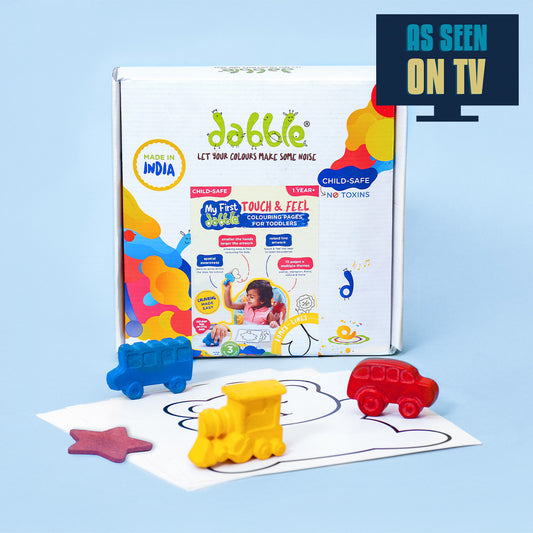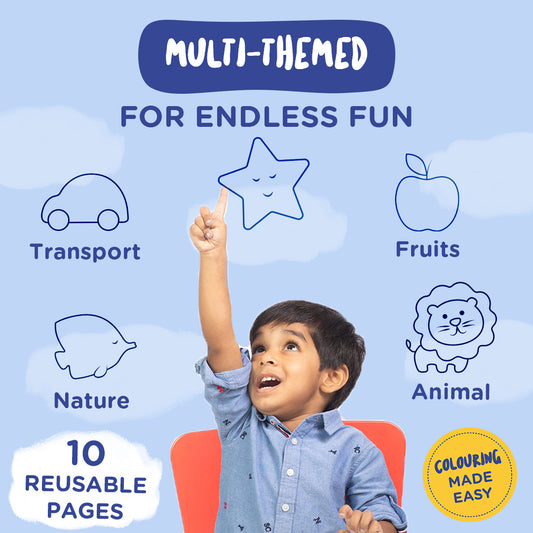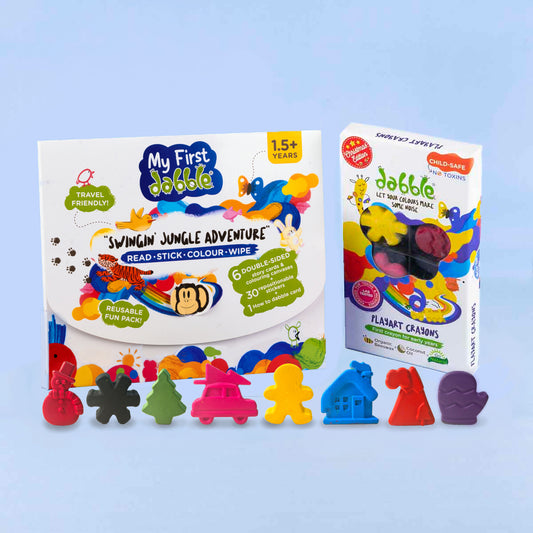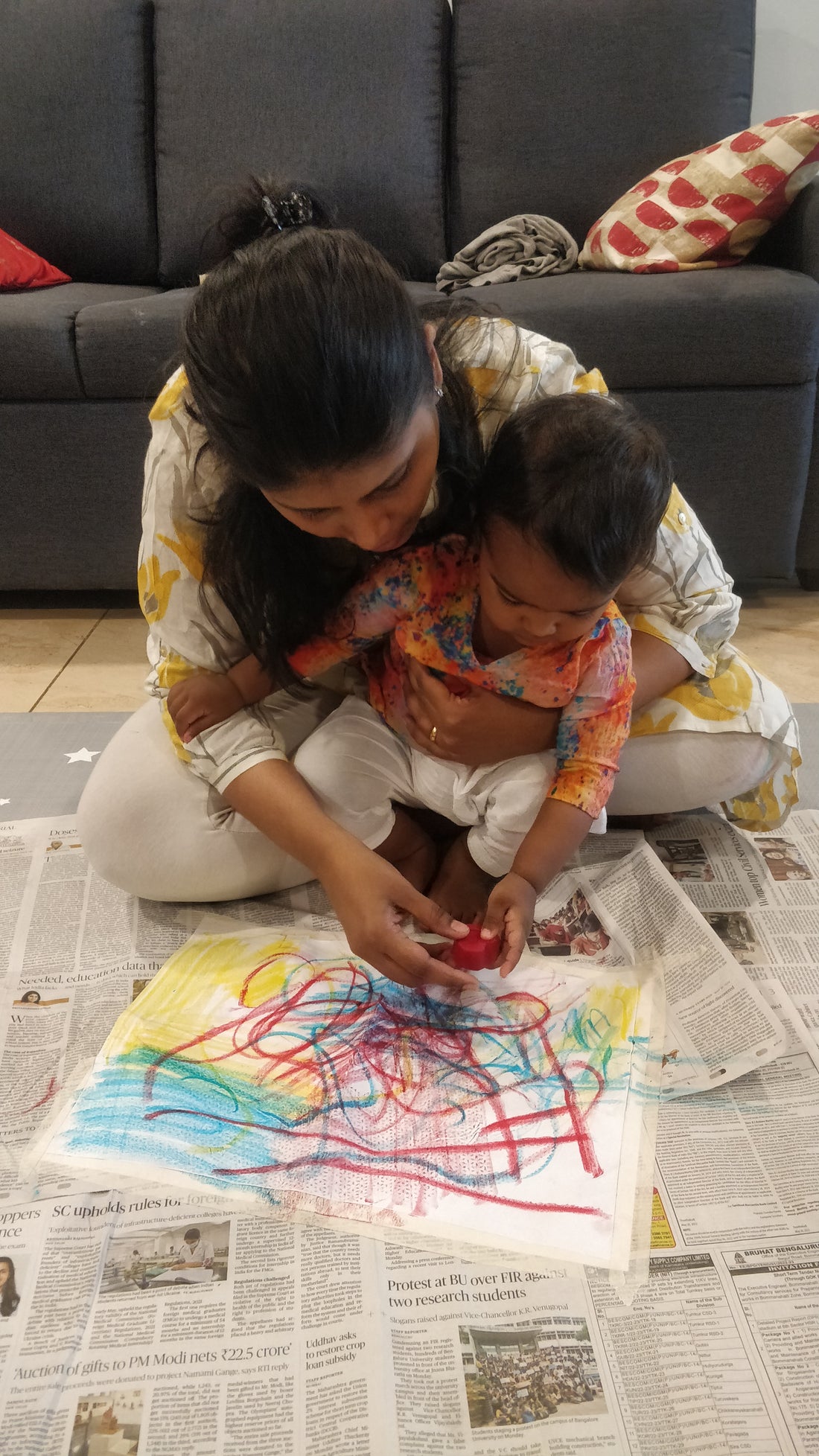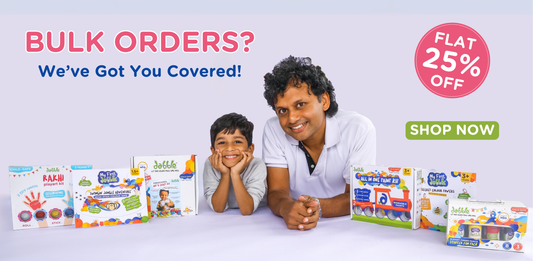Joy pervades when a child explores art for the very first time. A blob, a dribble, dots and scribbles, squiggles, smears, and splatters. A child's work of art takes up space on the refrigerator and these memories are forever etched in our hearts 💚.
Children may not have all the words in their vocabulary to communicate how they feel, but they find ways to express themselves. Do tantrums sound familiar? What if we could help them take all their big feelings and convert all their explosive energy into something positive? Art happens to be a fantastic medium of expression that has a calming effect on children. To be able to take a blank paper and create something on it is instant gratification. A great mood changer!!😁
While most children love the sensory pleasure of exploring the various mediums of art, some children might not be naturally inclined towards drawing, coloring, or painting. So here's an obvious albeit underrated object that greatly inspires artistic creativity - books!📚
Books stimulate imagination and spark creativity. Both of which are foundations of art. Reading makes us imagine scenarios and the pictures transport us to a different world. Reading about a secret garden might ignite a great desire to draw a lovely garden, and reading about foreign delicacies might have us yearning to try them out or have us picture what these foods might look like in our heads. Imagine reading Enid Blyton and giving a child a crayon and asking them to draw what they think scones (or any food that they might be unfamiliar with) might look like -- we would get such interesting works of art. When books are paired with artistic activities, children learn and express themselves better.
Young children are keen observers who absorb everything that they see in their early years. If you've already been reading to your toddlers, you might notice how they don't miss even the tiniest detail. A little star, a heart, a pattern on a character's shirt that might look like a sun, they see everything! The vibrant colors, the circles, lines, brush strokes, the quirky characters, etc attract children and inspire artistic creativity in them.
If you're looking for books for children, you can start by reading these books to them-
Angry Akku by Vinayak Varma (Ages 3+)
Akku has had an awful day and her bad mood seems to linger. Akku's appa notices that she's unhappy and gives her a box of crayons once they get home. Akku begins to draw about her day and she's soon able to express why she's upset. As she draws, she finds herself feeling better and continues to enjoy her doodling. A lovely book that can be used to gently nudge children to express how they feel by trying to draw about it.
Beautiful Oops by Barney Saltzberg (Ages 3+)
Many children get upset when they accidentally mess up their work of art. Beautiful Oops is a fantastic book to help kids embrace mistakes and have them relook at imperfections as creative opportunities. A smudge, a stain, a tear, or a fold, most errors can be transformed into something far more beautiful.
The Dot by Peter H Reynolds (Ages 4+)
A few children decide that they cannot draw and do not even try. They stick to the 'I cannot draw mindset' and continue to be hesitant in giving art a chance. In this fantastic book, Vashti a little girl who is at first reluctant to draw begins her journey with just a dot. Through the book, you can see Vashti expanding on the idea of a dot and exploring colors, mixing them, and even making dots by not making dots! A fantastic book to ignite the inner artists in children.
8 ways to draw an elephant by Paola Ferratotti with various artists (Ages 4+)
An Indian elephant is introduced to children through 8 different styles of tribal and folk art from across India. A book that provokes thought about how one thing can be depicted in many ways. Once you get the basic features right it's then all about letting your imagination soar. In this activity book, children get to trace and color the elephants. It also has a blank page at the end for children to try out their own unique style.
Mouse Paint by Ellen Stoll Walsh (Ages 0+)
A delightful book that introduces concepts of primary colors, secondary colors, color mixing, and camouflage to children. Three white mice find three jars of paints of primary colors to hide in. Once they're out of the jar, they begin leaving puddles of colors on paper. While stepping into each other's puddles, they accidentally discover that colors change when they're mixed. The process of mixing is depicted in a way that captures the interest of children. The dancing mice and their antics make this book perfect to entertain toddlers and have them wondering about the magic of mixing paints.
Eric Carle Books (Ages 0+)
If you have a toddler one can safely assume that you're familiar with Eric Carle Books and his charming works of art. Needless to say, his style is cheerful, bold, and enthralling. His unique collage technique has inspired several children around the globe to try their hand at art. Eric Carle Books are great if you're looking to introduce your children to scissors and glue. Let them observe the textures in any Eric Carle book and create collages using hand-painted papers.
Extra notes:
- Do not pressurize children to draw, color or paint. Give them access to art material and provide them with inspiration and opportunities. They will come around!
- While introducing crayons or paints to toddlers just scribble on a paper and let them have a go when they're ready. Avoid drawing a perfect shape or a picture, doing this might cause frustration in them and make them wonder why they're unable to do the same.
- When a child draws something, instead of asking them what it is that they have drawn, say something like - Could you tell me about your picture? It is discouraging to ask a child what they have drawn when they can see a clear dinosaur in their doodle.
- Hold off blunt praises. For example, instead of saying, 'Wow, that duck looks fantastic'. You may say something like -- I like that your duck is wearing sunglasses, is it a sunny day? I like how you spend time on tiny details or I like your choice of colors. Discuss the drawing of the child and keep the questions specific.
- Most caregivers just glance at the art of a child and say good, excellent, etc. And go back to being busy. A child can sense ingenuine and lazy feedback. If you're busy, tell them that their ‘work is interesting and that you'll have a good look at it when you're free.’
Get some amazing Dabble products today and let your child's creativity and imagination grow and blossom!! 🎨
Contributed by Sneha Caroline (Dabbler mom)
A mother of a 15-month-old and a doting aunt of a 6-year-old. A children's Books Expert, Art Enthusiast, and Nature Lover!
(Centre Manager at Hippocampus Children's Library and Experience Centre, Bangalore)
Know more about Sneha and Tips to Children's Books Expert https://instagram.com/mrs.moonbow?utm_medium=copy_link

